Sphene (Titanite) Gemstone: Meanings, Value & Information
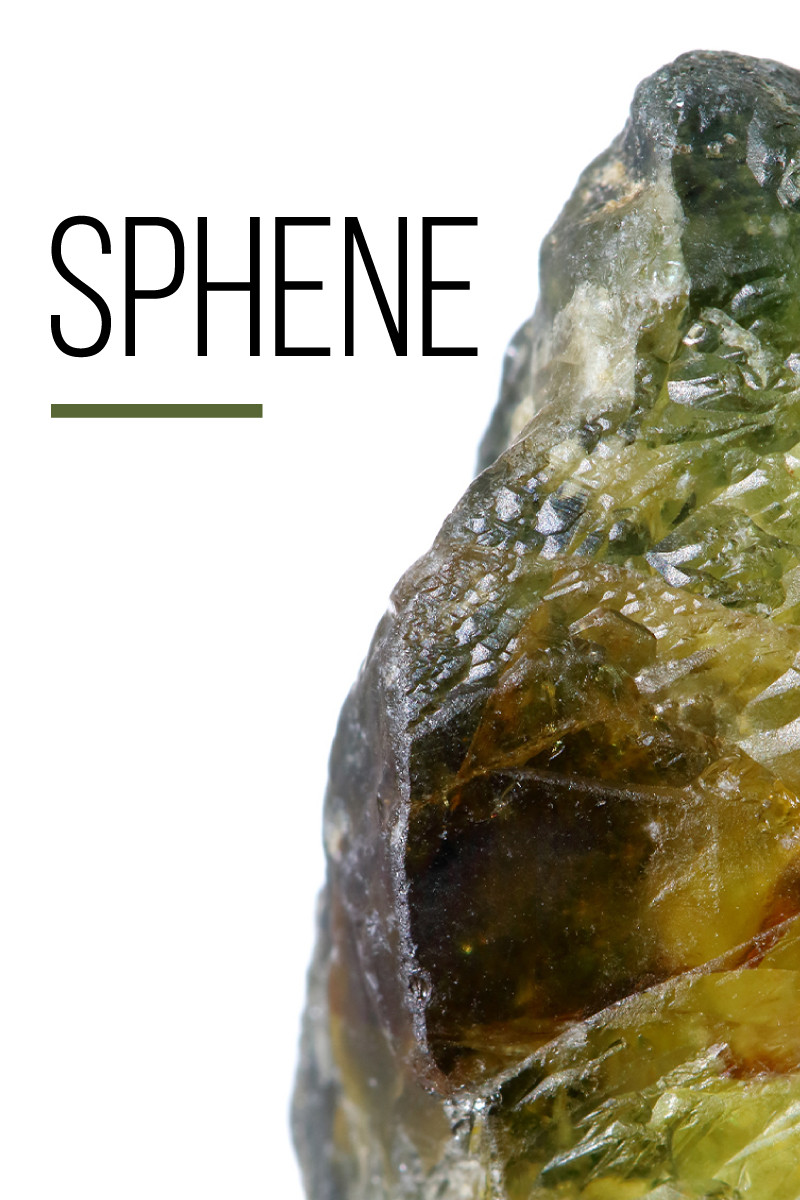 Sphene, or titanite, is a rare gemstone beloved by collectors for having a luster just below diamond's and a colorful sparkle exceeding diamond’s. That said, is sphene a precious stone? No, sphene is a semi-precious gemstone.
Sphene, or titanite, is a rare gemstone beloved by collectors for having a luster just below diamond's and a colorful sparkle exceeding diamond’s. That said, is sphene a precious stone? No, sphene is a semi-precious gemstone.
What color is sphene? It’s typically bright yellow-green but can range from colorless all the way to black. But, turn the stone under light and you'll see different colors — with a twinkling rainbow sparkle to match!
Already thinking of checking out sphene jewelry? Come along and discover sphene gemstone meanings, healing powers, prices, and more!

What Is A Sphene Stone?
Sphene is a titanium-rich variety of the mineral titanite and the only variety used for gemstones. That’s right, titanite isn’t just a synonym, it’s also a mineral family.
Besides gems, what is sphene used for? Titanite may be mined as a titanium dioxide ore for pigments.
Scientists also use titanites as geochronometers (tools for measuring geological history via radioactive decay) and thermobarometers (minerals for measuring the pressure and temperature during rock formation).
Wait, is sphene radioactive? Mildly yes. Fashioned or polished pieces are safe, while rough specimens are safe for short periods.
Sphene gems are more affordable alternatives for peridot. Therefore, you can use sphene as an August birthstone or 16th wedding anniversary gemstone in peridot’s place. Sphene itself is a zodiac stone for Libra, Sagittarius, and Taurus.

Sphene Specifications & Characteristics
Sphene is a calcium titanium silicate. Iron and aluminum are almost always present in sphene, along with rare earth elements (REEs) like cerium, thorium, and yttrium.
REEs can give the gem a “radioactive” bright green hue. However, the iron content is usually too high for sphene to fluoresce.
Some sphene minerals become metamict from cerium. Metamictization involves radioactive materials decomposing the crystal structure, leaving the stone amorphous.
All of sphene’s mineral properties are below:
Mohs hardness: 5-5.5
Color: Usually chartreuse, yellow, green, or brown; Can be colorless, blue, red, gray, or black; Color-zoning common
Crystal structure: Monoclinic
Luster: Resinous to sub-adamantine
Transparency: Transparent to translucent; Sometimes opaque
Refractive index: 1.84-2.11
Density: 3.45-3.60
Cleavage: Fair to good on [110]
Fracture: Conchoidal
Streak: Reddish-white, pink, or white
Pleochroism: Moderate to strong in transparent stones; Trichoic colors differ based on gem’s color, but usually light yellow, orange-brown, and brownish-yellow; Some blue crystals have colorless to blue dichroism
Optical effects: Very rarely color-changing
Some sphene properties (and types) slightly vary based on locale.
 Image: Chrome sphene variety
Image: Chrome sphene variety
Types of Sphene
There aren’t official sphene varieties, but we’ll highlight two unofficial types you may see while shopping:
Chrome Sphene: Valuable emerald-green variety colored by chromium, mostly from Baja, California, USA
Capelinha Sphene: Extremely rare, high-quality, lime-green variety from Capelinha, Brazil
Moving to the metaphysical, what is the meaning of sphene?
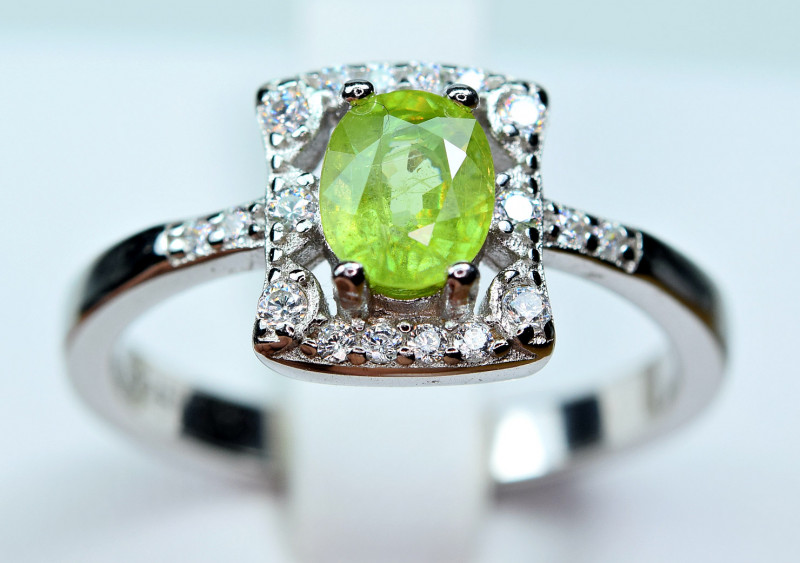
Sphene Meaning & History
Sphene symbolizes knowledge, innovation, and divine light. As for the spiritual sphene gemstone meaning, it’s a talisman for mediums, astrologers, and tarot readers.
The name “titanite” references the titanium content. “Sphene” derives from the Greek sphenos, meaning “wedge,” after its wedge-shaped crystals.
So, why is sphene called titanite? The short answer: Mineralogists generally prefer “titanite,” while gemologists prefer “sphene.”
The slightly longer answer ties into the stone’s history.
Marc-Auguste Pictet, a Swiss scientific author and researcher, first discovered titanite around Germany’s Bavarian Forest in 1787. However, it wasn’t until 1795 that the stone received its first official description and name from German chemist Martin Klaproth.
In 1801, acclaimed French mineralogist Rene Hauy created the name “sphene.” Both terms became widely used, though “sphene'' was more popular.
However, the International Mineralogical Association (IMA) claimed only “titanite” was correct, discrediting the name “sphene,” in 1982. Despite this, even peer-reviewed journals allow authors to use the name “sphene” for the gem.
Gradually, “titanite” became more common in mineralogy while “sphene” became more common in gemology.
Whichever name you use, the stone still has the same healing properties, which we’ll cover next!

Sphene Healing Properties
Gems have specific powers as healing stones based on their color, energies, and history. Green gemstones like sphene are used for heart chakra healing, manifesting success, and connecting with nature.
Mentally, sphene stones are often recommended for students or researchers, touted to support greater focus, memory, and information processing.
What other sphene crystal healing uses are there?
Physical Healing
Some purported sphene benefits include helping heal broken bones, resolving congestion, and boosting the immune system.
Emotional Healing
Sphene is thought to help you process your feelings, organize your thoughts, and balance any emotional extremes.
Any folks struggling with the single life? If you find yourself unfulfilled, sphene can help lower that emotional hunger for a relationship. Instead, it helps you accept yourself as you are and encourages self-love.
Sphene’s spiritual value? Definitely high! But what about sphene’s value as a gemstone?

Sphene Gemstone Properties
Like most gemstones, sphene’s value comes down to the “4 Cs.” Most influential are its clarity, color, and carat weight, followed by cut. However, these factors may interact with each other too — for example, a rich body color may obscure the sparkle, even with a good cut.
To learn more, let’s go over color first!
Color
Green, yellow, and brown are the most common sphene colors, with yellow-green being the most popular. Most of these specimens display color-zoned gradients.
The popular hues all come from rare earth elements and the amount of iron present — low iron creates yellow and green, while high iron creates brown and black. However, the most intense green chrome sphenes get their color from chromium.
Rarely, you’ll find a color-changing sphene gem coming out of Afghanistan or Pakistan. Some shift from yellow-green or green in daylight to brownish-orange under incandescent light because they contain vanadium. Others change from yellow-green or brownish-green to orange-yellow.
What color sphene is most valuable? Chrome sphene is rarest and most valuable. In general, lighter colors (namely green, yellow, and light orange) will carry greater value than even rich hues because pale colors display the stone’s dispersion best.
Dispersion, or fire, is when light reflects from a stone by splitting into a rainbow of colors. In other words: a rainbow sparkle! At 0.051, sphene’s dispersion outranks diamond’s (0.044).
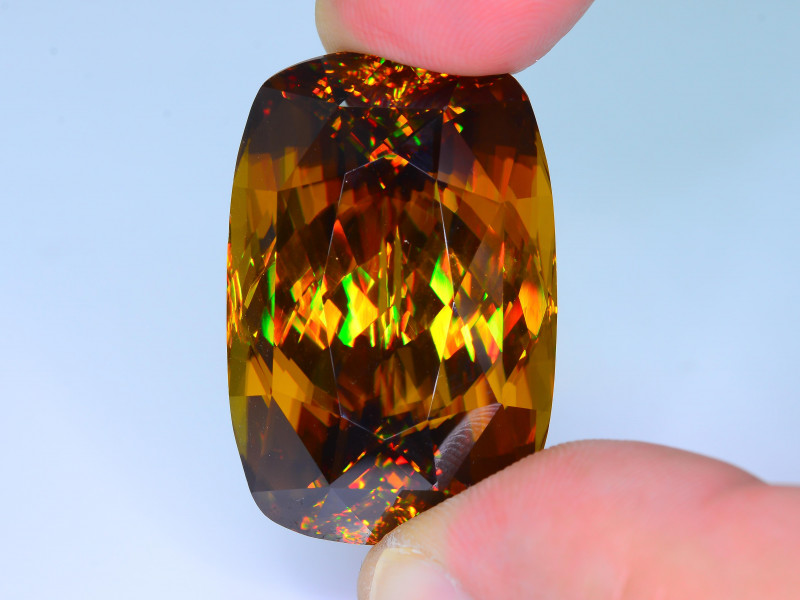
Cut
Sphene hardness is only mid-range, so cutting can be tricky. While polishing the stone can produce a diamond-like luster, this process is even more difficult than cutting. But those skilled enough to do it can create gorgeous, brilliant jewels.
Like color, sphene’s cut influences how well its dispersion shows. Brilliant faceted cuts, like round or princess, are best for displaying fire. For darker or less transparent stones, step cuts like emerald will also look beautiful but may be slightly less valuable.
Translucent to opaque specimens typically become cabochons, beads, or carvings.
Clarity
Sphene almost always has visible inclusions, giving it a Type III colored gemstone clarity grade.
Iron, aluminum, and rare earth elements are common inclusions. Typical patterns you might see are needles, fingerprints, feathers, or intergrown crystals.
You may see a haziness in some sphenes (especially under magnification) but not from inclusions. Sphene has high birefringence (double-refraction), meaning reflected light splits into two rays. This reflection makes the facets look doubled, causing a fuzzy internal appearance similar to peridot and zircon.
Carat Weight
Most sphene gemstones are under or around 1-2 carats. If stones reach 5-10 carats, they rarely have gem-quality clarity, making any good-clarity sphene over 5 carats pretty expensive.
Certain locales produce larger sphenes than others. Some specimens from Myanmar reach 20+ carats! Faceted sphenes from India and Madagascar are often 10 or 15 carats, respectively. Conversely, Brazilian and Sri Lankan sphenes are usually under 5 or 10 carats, respectively.
Treatments
Some sphenes are heat-treated to change their color to red or orange. Treatment often lowers value and should be disclosed before selling.
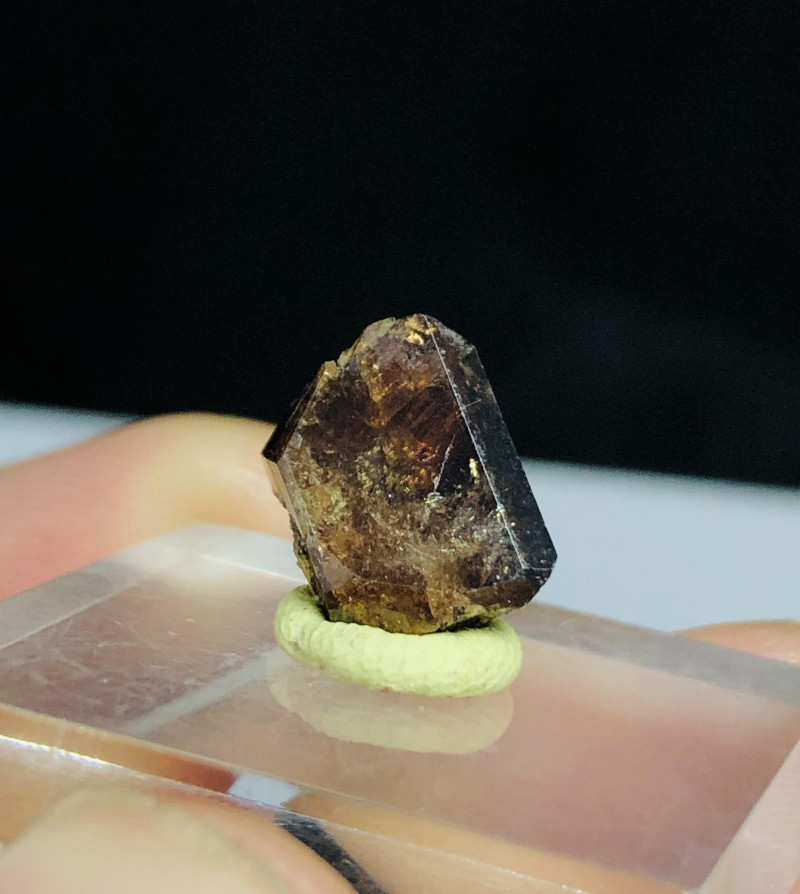
Sphene Formation & Sources
Most sphene raw crystals are small, but these tiny crystals are distributed across various igneous and metamorphic rocks. Sphene occurs as an accessory mineral, making up under 1 percent of the rock.
In metamorphic rocks, sphene grows within the cavities of schists, skarns, and gneisses. Some igneous rocks containing sphene are granite, pegmatites, diorites, and syenites.
As igneous rocks slowly cool and solidify from magma, water carrying other elements settles into pockets in the magma. The water evaporates and the remaining elements crystallize into sphene.
Those igneous rocks can become metamorphic from pressure and heat, along with mineral-rich water, that alters the rock’s composition. The conditions can also alter some crystals in the stone into sphene.
Mining Locations
The main sources for sphene are North America and Madagascar Many locales are known for their specific sphenes. Below, we’ll list all of sphene’s locations with the sphenes they’re known for (if relevant):
Afghanistan (some color-changing)
Brazil (often transparent; twinned; yellow to green; no birefringence; Capelinha sphene)
Canada (black and brown)
China
India (green, yellow, and brown; some of world’s largest & brightest)
Italy
Madagascar (yellow to green; twinned; transparent; sometimes large; lower birefringence)
Mexico (chrome, brown, yellowish-brown; up to four inches; higher birefringence)
Myanmar (sometimes large)
Pakistan (some color-changing)
Russia
Sri Lanka (honey-yellow, dark brown, and yellow-green; highest birefringence)
Switzerland
USA (Alaska; Maine; New York; California - chrome)
Sources aside, cost is a huge buying factor. What prices on sphene for sale should you expect?
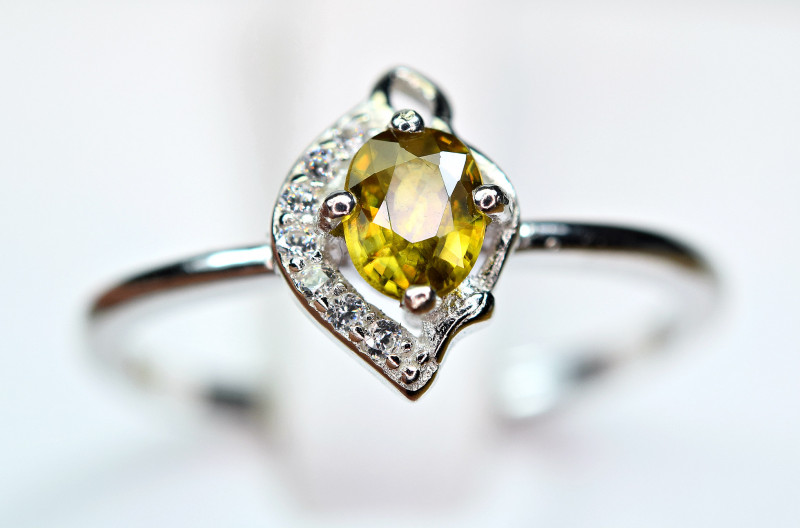
Sphene Gemstone Price & Value
Sphene’s prices are pretty reasonable, similar to tourmaline gems. The most expensive ones are faceted sphenes with good dispersion, strong color, and pretty good clarity.
At retail prices, about 50 percent of faceted sphene gemstones are $100-$1,000, followed by 20 percent being $50-$100 and 15 percent at $20-$50. Almost 75 percent of these retail gems are 1-5 carats.
Wholesale prices will be lower, and we’ll break those down below.
Overall, faceted chrome sphene with good dispersion is the priciest, from $50-$600 per carat for 1- to 10-carat stones and $200-$1,000 per carat for stones larger than 20 carats at wholesale. Faceted color-changing chrome sphenes are around $190-$475 per carat.
The sphene price per carat for the remaining colors of faceted gems are:
Color-Changing: $190-$475 per carat
Yellow: $70-$320 per carat (but some reach $650 per carat)
Yellow-Green: $30-$70 per carat
Green (not chrome): $30-$250 per carat
Orange: $50-$75 per carat for 1-10 carats
Now, the prices for sphene cabochons:
Color-Changing: $80-$120 per carat
Yellow: $1-$40 per carat
Green: $5-$60 per carat
Brown: $0.30-$9 per carat
Lastly, we have rough sphene, which costs $0.15-$5 per carat, though some rare specimens reach $20 per carat.
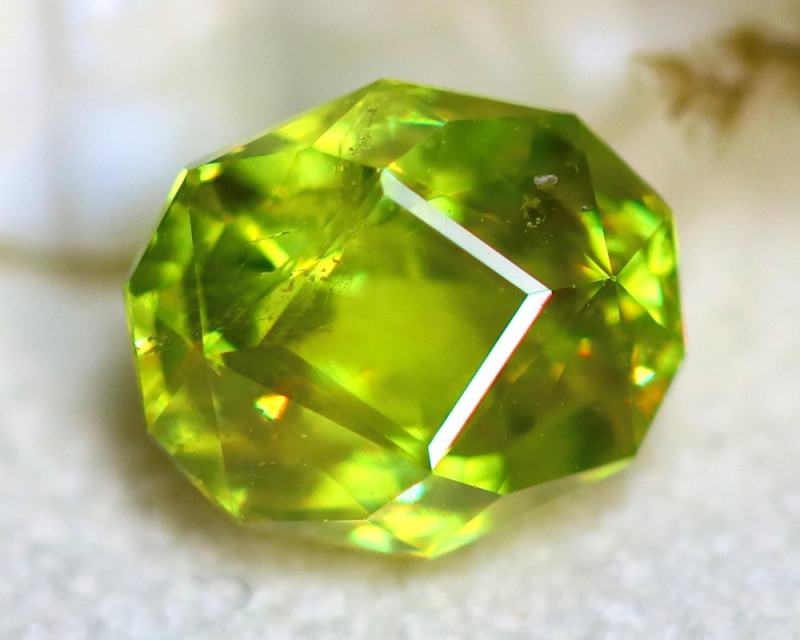
Sphene Care and Maintenance
Before we discuss gemstone care for keeping sphene safe, let’s go over the radiation aspect to keep you safe.
Any fashioned or polished pieces are safe to handle. Since sphene is only mildly radioactive, raw specimens are safe to handle for short time periods.
Given the stone’s fairly low hardness and brittleness, choosing vulnerable jewelry like a sphene ring isn’t recommended.
Other jewelry like a sphene necklace or earrings can be made safer from damage with protective settings and only occasional wearing. Plus, earrings and pendants are great for catching the light and showing that brilliant sparkle!
Only clean sphene with a soft brush dipped in warm water and mild soap. Don’t use ultrasonic or steam cleaners.
Keep sphene away from:
Heat
Acids
Excessive sweat
Hard impacts
Other gemstones (store separately)

Want A Gem Like None You've “Sphene” Before?
Whether you call it titanite or sphene, one thing is true: this gem is a brilliant jewel that belongs on display in any collection — or complementing a gorgeous outfit!
From earthy, bohemian brown pendants to out-of-this-world, vibrant green earrings and so much more, you’re sure to steal the scene in any sphene!
Was this article helpful?
2 people found this article helpfulRoss Sedawie
- Written - 30th Apr 2022
- Edited - 8th Dec 2023
Comments

















